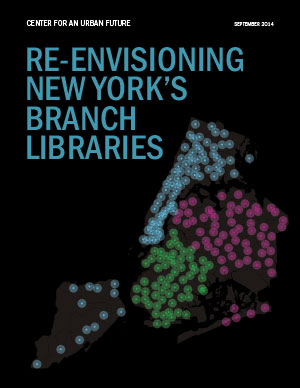Good afternoon. My name is David Giles and I am the Research Director at the Center for an Urban Future, an independent policy organization that publishes studies on how to grow and diversify New York’s economy and expand economic opportunity. I am excited to speak to you today about one of the city’s most important and underappreciated public institutions.
At a time when New York’s elderly population is one of its fastest growing demographics, youth unemployment is higher than it’s been in decades, and almost everybody is looking to upgrade their skills in an economy that values technology and English literacy above all else, community libraries have an important and unique role to play.
With 207 branches across the five boroughs, almost everybody is in walking distance of one, and with new and expanded educational programs, attendance is at an all-time high, growing 62 percent over the last ten years. In 2013, branch libraries greeted 36 million visitors, or approximately 160,000 every day they were open.
But New York’s three public library systems have struggled to keep their buildings in a state of good repair, much less up-to-date in meeting the space and technology demands of today’s users. In a recent report, the Center for an Urban Future documented $1.1 billion in capital needs across 178 branches, or 86 percent of all library locations. Fifty-nine branches across the city have at least $5 million in basic repair needs.
The most common state of good repair problems involve malfunctioning mechanical equipment, leaky roofs, overburdened electrical distribution systems, and a lack of accessibility for the elderly and physically disabled. In all, 64 branches across the city need HVAC repairs or replacements, 55 need roof repairs, 55 need to be made ADA compliant, 35 need boiler repairs or replacements, 32 need electrical system upgrades, and 23 need new elevators.
Reconfiguring layouts and adding basic service amenities to meet modern usage patterns and needs is another widespread problem. Far too many branches struggle to provide enough space for people to sit down and plug in their laptops and other mobile devices, for example. Out of the 45 branches we visited for our site surveys, 58 percent (or 26 locations) had plugs for ten devices or fewer, and 18 percent (or eight locations) had plugs for just one or none at all. In some cases, even very popular branches had a dearth of electrical outlets for patrons working on their own devices. The McKinley Park branch in southern Brooklyn, which ranks in the top ten citywide in both circulation and visits, doesn’t have a single place for patrons to plug in. In Queens, the popular Jackson Heights branch can accommodate only three devices at any one time, and all of those outlets are clustered in just one corner of the library.
Yet another thing most libraries are struggling to provide is sufficient space for onsite activities—including seating at desks and physically separated rooms for classes and workshops. In our survey of over 300 New York City librarians, not being able to accommodate onsite activities registered time and again as a top complaint: 87 percent of respondents indicated that their community rooms were insufficient to meet patron needs; 74 percent said they lacked sufficient space to ensure a quiet working environment; and 60 percent said their branch struggled to support people who wanted to work in groups.
New York’s capital funding process is largely to blame for this state of affairs.
Unlike most other agencies, libraries don’t receive a guaranteed capital budget to make systematic repairs, but instead raise funds from individual elected officials on a year-by-year and project-by-project basis. Nearly 60 percent of the libraries’ total capital budget comes from individual city council members and borough presidents through the discretionary funding process. The average for city agencies is just 6 percent.
Because discretionary dollars are limited, the libraries have to piece together funds from a wide variety of different sources, and they often have to break up projects into smaller, more manageable parts in order to get the construction and repair process underway. More than three quarters of the branches that have received capital upgrades since 2010 still have major repair needs that have gone unaddressed; 64 percent of those branches have needs totaling $1 million or more.
Doing everything in this piecemeal way makes it difficult to do long-term planning, since so much of the libraries’ planning capacity is geared toward raising funds for projects and figuring out how they can be stretched to cover their needs.
In “Re-Envisioning New York’s Branch Libraries,” we at CUF recommended that City Council and the Administration work together to repair and improve this process. Several important action items include the following:
-
Increase Administration capital funding for the city’s libraries, so that they don’t rely on the discretionary funding process to the extent that they do now.
-
Increase lump sum appropriations to allow the libraries to make repairs across the system rather than building-by-building and project-by-project.
-
Revisit capital eligibility requirements for libraries that place an undo burden on the capital planning and construction process and aren’t necessary for ensuring the financial integrity of the city’s capital fund.
-
Streamline the procurement and contracting process so that DDC and the libraries can make capital improvements in a more timely, cost-effective manner.
-
Create a Director of Libraries inside City Hall to help oversee library investments and align those investments with city policy priorities.
However, with the city’s libraries, one opportunity stands above the rest. As discussed in our report, there would be enormous benefits to creating a true, long-term capital plan for the libraries. With a firm financial commitment from the Administration and perhaps also City Council, the libraries could raise additional funds from philanthropy, as the Seattle Public Library did in the late 1990s when it launched a capital campaign to rebuild every library in the city. On the basis of a $200 million government bond, the Seattle Public Library was able to raise 30 percent in additional funding from private sources—that’s $60 million…in Seattle!
Moreover, a long-term capital plan would allow the city to better align library investments with important city policy priorities, including the de Blasio Administration’s ambitious new housing, resilience and workforce development initiatives.
Like schools, library investments should factor prominently in city upzonings and accompany major new housing developments that increase neighborhood density and put stress on vital community services.
They should also figure prominently in the city’s resilience and storm preparedness plans: After Superstorm Sandy, libraries in Queens, Brooklyn and Staten Island played important roles in the recovery, as residents came to the libraries to charge their phones, share information and retrieve blankets and food—and as Red Cross workers came to print out maps and plan their house-to-house checks. But the libraries in these communities were also severely damaged and their role in the recovery dramatically hampered.
Investments that were part of a long-term plan would better position these vital community assets to serve both residents and first responders in case of another storm. And given the sheer number of libraries in or near city evacuation zones, this should be a priority for officials at all levels of government. According to a recent analysis using library and Office of Emergency Management data, 74 different branches are located within York City evacuation zones, including 12 inside Zone 1. Meanwhile, 75 additional branches are within a half-mile walk of the evacuation zones.1
Together, these 149 branches have over $600 million in capital needs.
Now is the time for the city to think ambitiously about its libraries and reverse decades of neglect.
The de Blasio Administration’s recent accomplishments in pre-K expansion and park equity—and it’s ambitious goals with respect to affordable housing and workforce development—show that it is serious about quality neighborhoods, affordability and skills development for those New Yorkers who have fallen behind in today’s knowledge economy. A bold new plan to re-invigorate the city’s branch libraries would strengthen these efforts even more.
1Leah Meisterlin and Special Project Office.
This testimony was presented on December 10, 2014.



